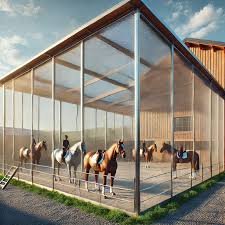Introduction To NSHorseScreen
In the fast-evolving world of technology, certain tools stand out because they serve more than one purpose and bridge gaps between industries that seem worlds apart. One such innovation is nshorsescreen, a system and concept that has gained attention in both the railway industry and the equine health sector. While the term may initially sound unfamiliar, its influence is growing as professionals look for smarter ways to handle complex tasks, whether it’s managing railway logistics or safeguarding the health of valuable horses.
This article takes an in-depth look at nshorsescreen, exploring what it is, how it works, its major features, who uses it, and why it is considered a forward-thinking solution in different fields. By the end, you will understand why nshorsescreen is not just another piece of technology but a transformative tool with wide-ranging benefits.
What Is NSHorseScreen?
The term nshorsescreen has developed a dual meaning. On one hand, it refers to a Norfolk Southern railway system tool that employees use for scheduling, crew management, and operational monitoring. On the other hand, it also describes a modern equine health monitoring device designed to track a horse’s well-being in real time.
This unusual duality makes nshorsescreen fascinating because it highlights how technology can adapt across industries. In railways, the system ensures that train schedules, crew availability, and operational data are updated and easily accessible. In equestrian circles, nshorsescreen represents innovation in animal healthcare, where advanced sensors and analytics bring early warnings of health issues that could otherwise go unnoticed.
Key Features Of NSHorseScreen
Real-Time Data Monitoring
One of the strongest features of nshorsescreen is its ability to collect and display information instantly. In the railway system, this means train schedules, crew assignments, and critical alerts are updated without delay. In the equine version, real-time monitoring covers vital signs such as heart rate, body temperature, and respiratory health.
User-Friendly Interface
Technology only works when people can use it easily, and nshorsescreen succeeds in this area. Its design is straightforward and practical, whether accessed through a computer terminal in the railway industry or through a mobile application for horse owners. This simplicity ensures higher adoption rates and minimizes user error.
System Integration
Another key feature of nshorsescreen is how it integrates with existing systems. For railways, it connects to employee portals, logistics tools, and safety reporting systems. For horse care, it links to apps that veterinarians and trainers can access, allowing data sharing and collaborative decision-making.
Advanced Analytics
Raw data is only useful when it can be interpreted, and nshorsescreen excels here with analytics that provide actionable insights. For Norfolk Southern, this might mean predicting staffing needs or identifying scheduling conflicts. For equine monitoring, the analytics highlight patterns in a horse’s health, giving early warnings of stress, fatigue, or potential illness.
Benefits Of Using NSHorseScreen
Improved Efficiency And Productivity
Railway employees benefit from smoother crew assignments and reduced delays, while horse trainers save time and gain more control over their animal’s training schedule. Efficiency is the cornerstone benefit across both industries.
Early Detection Of Issues
In horse care, nshorsescreen can alert owners about irregular heartbeats, abnormal gait patterns, or stress levels before they turn into serious problems. In railways, it can highlight logistical bottlenecks that could delay shipments or create crew shortages.
Cost Savings And Resource Optimization
By catching problems early, nshorsescreen reduces costs. Railways save on overtime and mismanagement expenses, while horse owners avoid costly veterinary bills that often result from late detection of issues.
Enhanced Safety And Reliability
Both horses and trains represent major investments, and nshorsescreen improves safety for both. It ensures horses stay healthy and trains stay on schedule, reducing risks and improving overall reliability.
How NSHorseScreen Works
Technical Process In Railways
Within Norfolk Southern’s system, nshorsescreen is accessed through a secure login. Employees use it to check crew calls, shift assignments, and schedule changes. Information flows into the system from multiple departments, and the screen acts as the central hub where it is organized and displayed clearly.
Technical Process In Equine Monitoring
In the horse health context, nshorsescreen relies on wearable sensors placed on the horse. These sensors measure vital data and send it to a connected app or dashboard. The app analyzes the data, detects trends, and generates alerts if abnormalities appear. Owners and veterinarians can then use this information to take action quickly.
Who Can Use NSHorseScreen?
Railway Employees And Managers
For train conductors, dispatchers, and logistics managers, nshorsescreen is an essential tool that streamlines operations. It simplifies communication and ensures that schedules are accurate.
Horse Owners And Trainers
Owners and trainers use nshorsescreen to monitor performance, recovery, and daily well-being. By having access to precise health metrics, they can make better training decisions and ensure the horse is not overworked.
Veterinarians And Animal Care Specialists
Veterinarians gain an extra advantage through nshorsescreen because it provides them with continuous data, something that traditional check-ups cannot offer. This helps them diagnose and treat more effectively.
Practical Applications Of NSHorseScreen
Railway Industry Example
Consider a situation where weather delays trains in one region. With nshorsescreen, Norfolk Southern managers can quickly see which crews are available, reassign shifts, and adjust schedules in real time. This reduces downtime and keeps operations running smoothly.
Equine Industry Example
Imagine a competitive horse showing early signs of lameness during training. With nshorsescreen, the subtle changes in gait or stress indicators are detected before the issue worsens. The trainer can then call a veterinarian early, potentially saving the horse from serious injury.
Challenges And Limitations
No technology is perfect, and nshorsescreen has its share of challenges. In the railway sector, it requires consistent training so that employees can use it effectively. Accessibility may also be limited to authorized staff only.
For horse owners, the main challenges include cost and the learning curve associated with using new technology. Additionally, while nshorsescreen provides valuable insights, it cannot replace professional veterinary care—it should be seen as a supportive tool rather than a substitute.
Future Of NSHorseScreen
Looking ahead, nshorsescreen is likely to evolve even further. In the railway industry, integration with artificial intelligence could lead to predictive scheduling, where the system automatically adjusts shifts before problems occur.
In the equine industry, future developments could include smaller, more comfortable sensors and the use of machine learning to predict health issues with even greater accuracy. The potential expansion into other animal health sectors, such as cattle or companion pets, is also a possibility.
Conclusion
The story of nshorsescreen is unique because it connects two very different industries under one concept: efficiency through smart monitoring. Whether applied to Norfolk Southern’s railway operations or the care of valuable horses, the principles remain the same—real-time data, analytics, and better decision-making.
For railways, nshorsescreen ensures schedules run smoothly and safety is prioritized. For equestrians, it brings peace of mind, early health alerts, and improved care for animals. With continuous advancements in technology, nshorsescreen is not just a present-day tool but a forward-looking solution that will keep shaping industries in the years to come.
Do Read: TekGPS Login – Secure Portal for GPS Fleet Management





